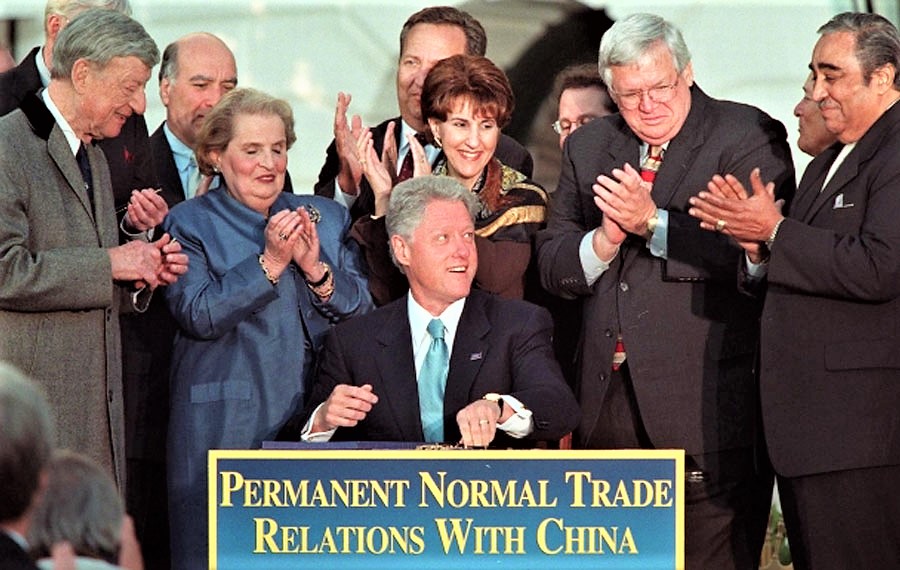How Clinton Admin Allowed China To Rob America’s Natural Resources; Laid Groundwork For Recent Threat To Cut Off Critical Supplies During COVID-19
By Robert Golomb
Editor’s Note: This is syndicated columnist Bob Golomb’s latest column as published in The Published Reporter and other media

On October 10, 2000, just around three months before his second and final term in office was to end, President Clinton signed The China Trade Bill into law. That law granted China even further access to American technology. Photo credit: AFP / Mario Tama.
NEW YORK, NY – “The Middle East has oil, China has rare earths,” Deng Xiaoping the “Supreme Leader” of China proudly and defiantly stated to America and to the world back in 1992. With China justifiably receiving world condemnation for its role in starting and spreading the coronavirus Xiaoping’s eight words might sound even more ominous today than they did then.
The Rare Earth’s to which Xiaoping was referring to are known in the scientific community as Rare Earth Elements (REE’s). REE’s are composed of a set of 17 complex elements, all of which are essential components of the products manufactured by America’s four most important industries- high-tech, pharmaceuticals, defense and energy; and incredibly, China now controls 80% of REE’s sales to America, and throughout the world.
It might come as a shock to the millions of Americans who regularly purchase such modern high-tech items as computers, Hi-definition-flat screen televisions, iPhones, iPads and laptops that the Chinese control 80% of the rare earth elements required to make these products. In other words, while it was American scientists, entrepreneurs and workers who helped build these products, it is the Chinese through their control of REE’s who have reaped the billions of dollars of profits derived from the components used to make them.
It might come as even more of a shock to the men and women who serve in the American armed forces that the Chinese possess (once again) 80% of the REE’s used to develop such essential military equipment and weaponry as night vision goggles, guided missiles, fighter jets and SONAR systems. In other words, the American armed forces are dependent upon China, widely viewed as our nation’s greatest military threat, to defend our nation in the event that Communist country launched an attack upon our homeland.
Further, Americans, particularly during this time of the coronavirus pandemic caused by China, would be shocked to learn that China, the nation, in large part due to its 80% control of REE’s market, manufacture 90% of all of the antibiotics prescribed in America, even as American pharmaceutical companies hold the largest number of drug patents in the world. In other words, we now almost fully rely upon China, the nation responsible for creating this awful health crisis, for the production of antibiotics developed in the U.S. to treat Americans suffering from almost every major bacterial infection, including, ironically, those especially unfortunate coronavirus victims who have also been inflicted with a related life threatening secondary bacterial infection.
Lastly, Americans who depend upon petroleum to fuel and run their cars, refrigerate their food, heat their homes in the winter and cool them in the summer (nearly every one of us) would be startled to learn that China controls (once again) 80% of the REE’s critical in refining this petroleum into gasoline, as well as other sources of energy. In other words, if China decided to end its supply of REE’s to the U.S., America could well become a third world nation.
Sadly, history informs us that it should have been America rather than China dominating the mining, processing and marketing of these precious elements.
That history of REE’s began in 1787 in the mountains of the nation of Sweden. There, a scientist named Lt. Colonel Carl Axel Arrhenius made the first recorded discovery of REE’s. However, it was a discovery which Sweden chose not to take advantage of at the time, and thus made little impact upon them or the rest of the world for the next 170 years.
But that was to change beginning in December, 1941 with America’s entry into World War II (1941-1945). As that devastating war continued, which before it ended was to claim more than 60 million lives across the globe, hundreds of America’s top scientists worked in Los Alamos, New Mexico on a program code named the “Manhattan Project.” The challenge of these scientists, who included the famed Robert Oppenheimer, Edward Teller and Enrico Fermi, was to discover the secret of how to split the atom for the purpose of building an atomic bomb.
The key to unlocking that secret, American scientists discovered in 1944, was that REE’s were the essential components used in the complex process involved in purifying uranium to the minute level required to build and detonate an atomic bomb.
Applying that knowledge, America built two atomic bombs. The first- detonated over the Japanese city of Hiroshima on August 6, 1945, killing more than 90 thousand people, and the second- dropped over Nagasaki three days later, killing an estimated 40,000 – ending WWII with the surrender of Japan on August 15, 1945.
With the devastating war finally over, American scientists, understanding the importance of REE’s, discovered in the mountains of southern California in 1954 an enormous mine containing the largest quantity of this precious element then known to the world. That mine, later named The Mountain Pass California Mine (MPCM), along with the top American scientists who became proficient on how to mine and refine the REE’s extracted from it, seemingly guaranteed the continuance of the U.S.’ almost total control of this history altering natural resource.
Still, with the notable exception of the discovery in the early 1960’s of the color television by REE’s research scientists, America’s total control of REE’s was put to little commercial use to benefit the average American, rather primarily remaining within the domain of our domestic defense industries and the U.S. Pentagon.
But that was to change in the early to middle 1980’s, due to the genius and ambition of one of the most financially powerful and most politically influential American corporations, the automobile giant, General Motors (GM). It was during those years that GM secured multi-million-dollar Pentagon grants, which GM’s researchers used to develop a new category of REE’s, Heavy Rare Earth Elements (HREE’s). From there, scientists soon made another major discovery: HREE’s could be refined and transformed into a new category of magnets, permanent magnets.
Many times more powerful than the existing magnets that they largely replaced, these heavy rare earth based permanent magnets became the magnets used by most major American industries. With the advent of these more powerful magnets, speakers in stereos, earphones and televisions became louder and longer lasting; computers became smaller and faster; automobiles became safer and better equipped; fossil fuel became easier for drillers to extract from the earth and refine into gasoline; MRI’s presented clearer images for doctors to read to detect diseases and injuries; and drugs became less expensive to manufacture and cheaper to buy. But this success was to present GM with a new challenge.
By 1986, GM, finding it increasingly difficult to keep up with the growing demand for these revolutionary magnets, created a separate division, Magnequench, to take over the job. Housed in Indiana, Magnequench, was in 1987 assigned the daunting task of manufacturing permanent magnets throughout America and most of the western world.
Magnequench accomplished just that. In the seven years leading up to 1994, it solidified its national and international control of the sale and production of permanent magnets. In short, during that time span permanent magnets were made in America by American workers and sold in America and throughout the rest of the world, as also were the original REE’s (then named Light REE’s, (LREE’S) to distinguish between the 2) and HREE’s, which continued to be used for a multitude of commercial and military purposes. But that was to change. And, it is here that the malign presence of China begins to be felt.
After decades of heavily government funded successful domestic mining for LREE’s and HREE’s, China – aided by cheap labor and an absence of environmental restrictions – had by 1994 actually surpassed America in the mining of these elements. However, the Chinese were still faced with one enormous problem: they lacked the technical expertise to refine HREE’s into its most sought-after by-product, permanent magnets.
The Chinese, though, were to find a way. And from here the story becomes ugly. In 1995, GM, still the legal owner of Magnequench, had agreed to sell its lucrative subsidiary for the relatively small asking price of $70 million to the little – known company, the Sextant group, a small consortium owned by wealthy Chinese and American nationals. While drawing little media attention at the time, the relatively minor asking price of $70 million for a company controlling advanced technology designed for both military and commercial uses to a partially foreign owned company should seemingly have created very serious concerns and a corresponding careful investigation by then President Clinton (1992-2000).
As president, Clinton, through a 1988 federal law, had been granted the power to block any financial transaction made between an American and a foreign owned company, were it determined, as the law was written, that “there is credible evidence that leads the President to believe that the foreign interest exercising control might take action that threatens to impair national security.”
Clinton apparently did not find such “credible evidence.” Or to be more precise, the Committee on Foreign Investment in the United States (CFIUS), a federal agency that had been established under the Reagan Administration to review such complex transactions, found no such evidence. So, with the stamp of approval of the CFUIS, the sale went through in 1995, even as little media attention was given to the fact that CFUIS was under the tight control of the Clinton Administration.
From there on, the ugly picture became even more filled with the face of President Clinton. That same year, his Administration made the decision to totally shut down the doors of the U.S. Bureau of Mines, which had been the leading global player in the research and development of energy sources, including LREE’s and HREE’s; and equally disturbing, during that same time span, Sexton began the process of shutting down the Magnequench plant in Indiana and transferring all operations to a factory located in China, all while President Clinton remained remarkably silent.
And in 1998, just 3 years later, the Clinton Administration placed its sights on the mostly rare earth developed mine in the U.S., the aforementioned MPCM. And here, Clinton once again utilized the power of a government agency, the powerful Bureau of Land Management (BLM), along with other federal and state agencies to assist him. Claiming that the mine’s very existence threatened an “endangered species” (the Desert Tortoise), BLM began to pound MPCM with a series of punishing legal actions. It did not take long for MPCM (coincidingly also facing the expense of repairing an environmentally hazardous broken water line) to succumb: After spending millions of dollars attempting to comply with BLM’s demands, though still not declaring bankruptcy, MPCM was forced to shut down all operations. China seemingly could not have asked for more from the Clinton Administration.
However, Clinton’s assistance to China at the expense of American interests did not even end there. On October 10, 2000, just around three months before his second and final term in office was to end, President Clinton signed The China Trade Bill into law. That law granted China even further access to American technology, including technology related to LREE’s, HREE’s and permanent magnets – over all three of which China by then had already gained its aforenoted 80% global control – thanks to the help provided by President Clinton.
While it would sound nice to say that Presidents George W. Bush (2000-2008) and Barack Obama (2008-2016) took actions during their combined 16 years in office to reverse Clinton’s hideous policies, that unfortunately, would not be true. Rather, each separately allowed the last fleeting chance to regain America’s preeminence in the rare earth industry to disappear. That last fleeting chance, ironically, returned with the re-emergence of our old friend, the Mountain Pass California Mine.
In 2008 during the final year of the Bush presidency Molycore a newly formed American company purchased a then non-operational MPCM. The nascent company’s goal, which it spent a total of one billion dollars to achieve, was to return the mine back into working mode and eventually return it to its prior dominance. However, that was not be.
Faced from the day of its launching through the following seven years of the Obama Administration with the same obstacles that had confronted the former owners of MPCM – cheap labor and the negligible environmental laws benefiting its Chinese competitor – and equally problematically, also faced with an increasing number of financially debilitating environmental regulations imposed first by the Bush and then the Obama administrations, Molycorp filed for bankruptcy in June, 2015 – and soon after it was placed under the administrative control of a United States Bankruptcy Court.
Incredibly, from within that court, China was to find yet another American friend: in June 2017, two years after the bankruptcy proceeding had begun – just five months after Donald Trump was sworn in as the 45th President of the United States – the Court agreed to sell the rights of MPCM to MP Materials, a consortium owned by American and Chinese companies, including, and here it becomes purposely tricky, the Chinese affiliated Shenghe Rare Earth Shareholding Company (SRESC). The price? An absurdly trifle $20 million. A small price for SRESC to pay at the time for further cementing China’s comprehensive control of the REE’s industry.
However, any party that SRESC and their Chinese Communist Government masters might have planned to celebrate the benefits derived from this one-sided deal would have had to be cancelled- for them the party killer was President Donald Trump. Beginning in the early months of his Presidency, there began to be some bad news for the Chinese and some good news for Americans, for the first time in the nearly 20 years since this fiasco began.
Quickly grasping the dangers that the Chinese control of both categories of REE’s and permanent magnets presented to America’s economic and military interests, Trump, on July 25, 2017, just six months after assuming office, issued a Presidential Declaration directing the federal government to develop a plan to reduce America’s reliance on China to supply these vital elements.
That declaration was soon followed by another important initiative. On December, 20, 2017, the President signed Executive Order 13817, “A Federal Strategy to Ensure Secure and Reliable Supplies of Critical Minerals,”– an on-going act providing increased federal funding for American Defense agencies and American privately-owned companies to produce light and heavy REE’s, and other critical elements.
Trump was not done there. Invoking, on July 22, 2019, a section of the Defense Production Act, Trump authorized the federal government to supply funds to American corporations for the domestic mining and processing of both categories of REE’s, as well for producing Rare Earth based permanent magnets.
Lastly, Trump also began to provide federal funds to several American Universities to support research to find the best methods to domestically produce and develop LREE’s and HREE’s. Currently, West Virginia University and several other universities are using those funds to develop methods to make rare earths from coal or coal-derived properties.
Still, while very promising, all of these efforts remain in their early stages, leaving America with a lot of ground to cover before it can catch up with and hopefully surpass China in the production and development of both forms of these REE’s and permanent magnets. And the stakes could not be higher.
With America in the midst of the coronavirus pandemic, the same Chinese Government that started this horror, through a state controlled national newspaper recently threatened to cut the supplies of drugs and other medicinal products it exports to America, warning it would result in plunging our great nation “into the mighty sea of coronavirus.”
It is up to President Trump to continue to take the creative and bold actions that will prevent China from making good on that or similar threats, now, or any time in the future.
————————————————-
Robert Golomb is a nationally and internationally published columnist. Mail him at MrBob347@aol.com or follow him on Twitter@RobertGolomb





